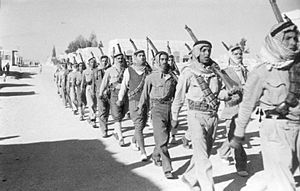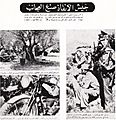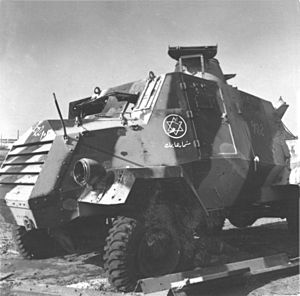Arab Liberation Army facts for kids
Quick facts for kids Arab Liberation Armyجيش الإنقاذ العربي Jayš al-ʾInqāḏ al-ʿArabiyy |
|
|---|---|

Emblem of the Arab Liberation Army
|
|
| Leaders | Fawzi al-Qawuqji |
| Dates of operation | 1947–1949 |
| Headquarters | Damascus, Syria |
| Active regions | |
| Ideology | Arab nationalism Pan-Arabism Anti-Zionism |
| Size | 6,000 |
| Allies |
|
| Opponents | Before 26 May 1948:
After 26 May 1948 : |
| Battles and wars | 1947–1949 Palestine war 1947–1948 civil war in Mandatory Palestine
|
The Arab Liberation Army (ALA), also known as the Arab Salvation Army, was a group of volunteers from different Arab countries. It was led by Fawzi al-Qawuqji. This army fought on the Arab side during the 1948 Palestine war.
The Arab League, a group of Arab nations, created the ALA. They wanted it to be a strong force. However, the League and Arab governments actually stopped many people from joining.
In February 1948, a meeting in Damascus decided where the ALA would operate. Northern Palestine was given to Qawuqji's forces. However, the West Bank was already controlled by Transjordan.
The goal was to recruit 10,000 volunteers. By March 1948, about 6,000 people had joined. The actual number of soldiers fighting might have been closer to 3,500. Most volunteers were from Syria, Lebanon, and Palestine. There were also hundreds of Iraqis, Jordanians, and members of the Muslim Brotherhood from Egypt. Some Circassians and Bosniaks also joined. A few soldiers from Germany, Turkey, and the United Kingdom also joined after leaving their own armies.
Contents
Who controlled the Arab Liberation Army?
The Arab League Military Committee was in charge of the ALA. Their main office was in Damascus. This committee decided where the army would go and how it would get supplies.
The committee included important generals and colonels from different Arab countries. These countries were interested in King Abdullah's plan for a "Greater Syria." This plan aimed to unite several Arab regions under his rule. The British Empire had supported this idea for many years.
Why did Syria create the ALA?
Syria had several reasons for helping to create the Arab Liberation Army. Syria's President, Shukri al-Quwatli, knew his own army was not very strong. He thought it was safer to influence the situation in Palestine using a volunteer army. This army would be paid for and armed by all Arab League countries.
Egypt was supposed to pay 42% of the costs. Syria and Lebanon would pay 23%. Saudi Arabia would pay 20%, and Iraq the remaining 15%.
Another important reason was to protect Syria's own army. By sending volunteers into battle, President Quwatli hoped to avoid risking his own troops. If the volunteer army lost, the embarrassment would be shared by the Arab League. It would not fall on Syria alone.
An army of volunteers could also enter Palestine before the British officially left. The British mandate ended on May 15, 1948. Arab states did not want to openly declare war on the British. So, Syria would not officially be fighting British troops.
If other Arab countries didn't send their armies, Syria would still be involved. This would show the Syrian public that their government was helping Palestinians. Most importantly, the ALA was meant to stop King Abdullah's "Greater Syria" plan. Syria did not want him to expand his kingdom into Palestine.
President Quwatli's plan was to prevent Abdullah from moving north towards Damascus. He also hoped Syria could gain some control over northern Palestine. He was worried about his own army's strength and loyalty. So, he wanted to keep the Syrian army out of the fighting. Instead, he built the Arab Liberation Army.
Syria's Prime Minister, Jamil Mardam Bey, also explained why a volunteer army was needed. He believed the Arab governments were not dependable. He thought it was best to support the Palestinian people directly. He worried that if Arab armies, especially Syria's, were defeated, their reputation would be ruined. He felt it was better for the Palestinian people to lead the fight. If they failed, it would be their failure, not the Arab governments'.
Leaders like Quwatli and Mardam wanted to limit Syria's involvement to the ALA. They believed the Syrian army was not ready for a big fight.
However, there were disagreements among Arab leaders. The Mufti, Hajj Amin al-Husayni, did not want Fawzi al-Qawuqji to lead. He wanted all money to go directly to him. King Abdullah also wanted to lead and was arming his own supporters. King Faruq of Egypt did not trust any of them. These disagreements meant there was no clear plan for the Arab military campaign.
ALA enters Palestine
On January 8, 1948, a group of 330 ALA soldiers entered British-controlled Palestine from Syria. This group, called the "Second Yarmuk Battalion," set up its base near Tarshiha in the Galilee. On January 20, they attacked Kibbutz Yehiam but were unsuccessful. The British High Commissioner asked Syria to stop the invasion.
Later on January 20, a second ALA group, the "First Yarmuk battalion," entered Palestine. This group had 630 soldiers and crossed the Jordan River at the Damia Bridge. British police tried to stop them, but the Arab Legion helped them pass. So, the British could not stop the invasion, even with protests from the Jewish Agency. Fawzi al-Qawuqji joined this group near Tubas. On February 15, 1948, they attacked Kibbutz Tirat Zvi but failed to capture it.
Another group, the Hittin Battalion, crossed the Jordan River on January 29, 1948. They spread out in the mountains of Samaria.
The ALA groups that came from Transjordan split into smaller units. They were sent across Samaria to keep order. This also helped Abdullah I of Jordan to take control of the area for his kingdom. Samaria actually remained one of the calmer areas in Palestine because of the ALA's presence. This move was approved by British official Ernest Bevin. He agreed to Abdullah's plan as long as it didn't cause problems with the UN Security Council.
Qawuqji went back to Syria to organize more forces. In March 1948, he returned to Palestine with two new groups, "Al Hussein" and "Al Qadsia," each with 360 soldiers. A final group, the "Jabal al-Arab" battalion, had 500 Druze soldiers. They settled in Shfar'am.
The Druze forces fought in the battle of Ramat Yohanan. After a tough battle, their commanders agreed to pull back. Some Druze soldiers later left the ALA and joined the IDF. They formed the first Druze units in the IDF.
On March 5, 1948, Qawuqji set up his headquarters in Jaba village. He also started a radio station that broadcast messages in Hebrew, Arabic, and English.
On April 4, 1948, ALA forces attacked Kibbutz Mishmar Haemek. They wanted to capture it and connect with Arabs in Haifa. This fight lasted ten days and ended in defeat for the ALA. Another ALA group was defeated in the battle for Safed. ALA units also fought in other areas, like the battle of Jerusalem, the Sharon region, and cities with mixed populations like Jaffa. In some places, they fought strongly against Jewish forces. However, on May 27, 1948, Qawuqji led his northern forces back to Syria to reorganize.
Final battles of the war
In June 1948, the ALA returned to the Galilee region. They helped retake Malkiya on June 5. During the "ten days battles," ALA forces attacked Jewish forces in Sejera. But they had to retreat when Nazareth was taken by the IDF. During a ceasefire, the ALA remained active. For example, they took several small bases near Moshav Manof.
In October 1948, the ALA captured a post near Manara. An attack by the Carmeli Brigade to retake it failed. In response, the IDF started Operation Hiram. This operation aimed to remove the ALA from their strongholds in the Galilee. The operation began with an attack on the ALA's headquarters at Tarshiha, which was captured by IDF forces, including the new Israeli Air Force.
Even though the ALA suffered many losses, Qawuqji managed to escape with most of his army. They left Palestine for Lebanon mostly intact. The ALA never returned to Palestine and was officially ended in the months that followed.
| Where the Arab Liberation Army Was in March 1948 | |
| Samaria | 3,000–4,000 soldiers |
| Galilee | 1,000 soldiers, in smaller groups |
| Haifa | 200–300 soldiers |
| Jerusalem city | a few hundred soldiers |
| Jerusalem district | maybe 500 soldiers |
| Jaffa town | 200 or more soldiers |
| Gaza Subdistrict | maybe 100 Egyptian soldiers |
| Source: Levenberg (1993), p. 200 | |
The Unit of the Minorities
In the summer of 1948, some Druze fighters left the Arab Liberation Army. These were mainly Druze from Syria and from villages on Mount Carmel. They joined the Israel Defense Forces. These soldiers formed the main part of the IDF's only Arabic-speaking unit, called the Unit of the Minorities.
See also
- Palestine Liberation Army




